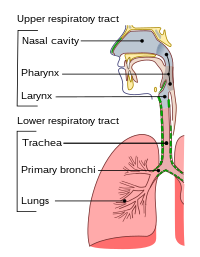
Photo from wikipedia
Abstract Background Rapidly growing mycobacteria (RGM) have high rates of antibiotic resistance and require prolonged therapy with considerable toxicity. Less toxic and more effective therapies are needed. One promising agent… Click to show full abstract
Abstract Background Rapidly growing mycobacteria (RGM) have high rates of antibiotic resistance and require prolonged therapy with considerable toxicity. Less toxic and more effective therapies are needed. One promising agent is clofazimine (CFZ), an antibiotic with favorable in vitro data but limited clinical data in RGM. Methods We performed a retrospective cohort study to assess outcomes of adult patients treated with CFZ for RGM infection. Primary outcome was cure, defined as no evidence of clinical, radiographic, or microbiologic recurrence within 1 year of follow-up after stopping treatment. If a patient was retreated for infection, only the index treatment was included in the analysis. Results We treated 55 adults for RGM infection with CFZ in combination with a median of 5 other antibiotic classes over the entire course of treatment. Of these patients, 58% had pulmonary infection (81% nodular-bronchiectatic and 19% cavitary); 100% of pulmonary infections were M. abscessus. Non-pulmonary disease sites included skin (65%), bone (13%), intra-abdominal (9%), and other (13%); 48% were M. abscessus, 39% were M. chelonae, and 13% were M. fortuitum. Patients with pulmonary infection were treated for a median duration of 11.9 months and non-pulmonary for a median of 7.9 months. CFZ was well tolerated. There were 2 (4%) cases of hepatitis and 3 (5%) cases of QT prolongation. For patients who completed treatment for pulmonary infections (n = 27), 67% achieved symptomatic improvement, 65% achieved radiographic improvement, and 71% achieved negative cultures. For patients who completed treatment for non-pulmonary infection (n = 22), 100% achieved clinical improvement. For patients who had at least 1 year of follow up after stopping antibiotics (pulmonary n = 21, non-pulmonary n = 14), 43% of patients with pulmonary infections achieved clinical cure and 79% of patients with non-pulmonary infections achieved clinical cure. Within 1 year of follow-up 19% of pulmonary infection patients and none of the non-pulmonary patients had died. Conclusion As a part of multidrug therapy, CFZ is useful in the in the treatment of drug-resistant RGM infections, particularly skin infections, and offers a better tolerated option compared with other available antibiotics. Disclosures All authors: No reported disclosures.
Journal Title: Open Forum Infectious Diseases
Year Published: 2017
Link to full text (if available)
Share on Social Media: Sign Up to like & get
recommendations!